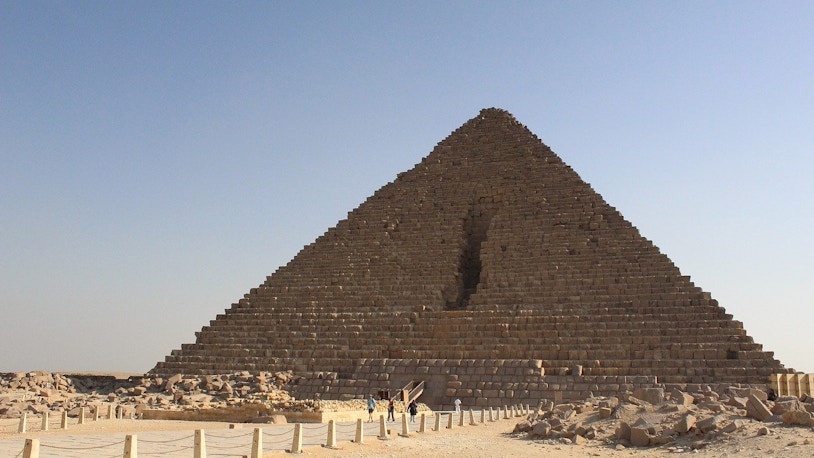The Pyramid of Menkaure: The Third Pyramid of Giza
As one of the seven wonders of the ancient world, the Pyramids of Giza are a true testament to the architectural and engineering prowess of the ancient Egyptians. Among these majestic structures lies the Pyramid of Menkaure, the smallest of the three pyramids yet one of the most fascinating. This monument holds historical significance and an intriguing mystery surrounding its interior layout and purpose. Join me as we delve into the secrets of the Pyramid of Menkaure and unlock the mysteries surrounding this ancient wonder.

Location and Size
Welcome to the Pyramid of Menkaure, the smallest of the three major pyramids at the Giza Plateau. Built by the ancient Egyptian pharaoh Menkaure, this pyramid may be small, but it holds some of the most stunning examples of sculpture to survive throughout Egyptian history. With a height of 65 meters (213 feet), Menkaure's pyramid complex was completed around 2510 BC. It was designed to serve as his tomb alongside a valley temple, a causeway, a mortuary temple, and three subsidiary or queen's pyramids. Despite its smaller size, the pyramid's complex chambers are more complicated than the other two pyramids, including a chamber carved with decorative panels and another chamber with six large niches. It is lined with massive granite blocks, and Menkaure's black stone sarcophagus, also carved with niched panels, was discovered inside, although it was lost at sea in 1838 as it was being transported to England. Within Menkaure's mortuary and valley temples, several stunning diads showing the king being embraced by various deities were discovered, including the dead of King Menkaure, now in the Museum of Fine Arts Boston. The pyramid was built using millions of blocks of limestone and granite, and its builders included between 5000 to 20000 workers and their families who were all housed on the Giza plateau. The unfinished nature of the granite blocks indicates that Menkaure died before construction was complete, and the pyramid was likely finished around 2510 BC by Shepseskaf, Menkaure's successor. Despite its incompleteness, the Pyramid of Menkaure remains an awe-inspiring sight to behold and is a testament to the creativity and ingenuity of the ancient Egyptians. If you're planning a trip to Egypt, visit the Giza Plateau and see the Pyramid of Menkaure. [1][2]

Purpose and Construction
Welcome to the Pyramid of Menkaure, the smallest yet fascinating pyramid among the three on the Giza Plateau. Pharaoh Menkaure built this pyramid complex in the 26th century BC, and it was the last built during the Old Kingdom. Its construction served as the final resting place for Menkaure and comprised a king's tomb, a valley temple, a causeway, a mortuary temple, and three queen's pyramids. Unlike its two bigger neighbours, it no longer retains its original polished limestone casing. Despite its incomplete construction, archaeologists consider this marvel a testament to ancient Egyptian architecture.
Menkaure ruled Egypt during the Fourth Dynasty and is believed to have had at least two wives and several half-brothers who served as viziers during his reign. Although the length of his ruling period remains uncertain, his pyramid's incomplete nature indicates that Menkaure died before its completion, and his successor Shepseskaf finished the project around 2510 BC. The pyramid is 62 meters, making it the smallest among the three. An estimated 5,000 to 20,000 workers and their families built the pyramid using millions of blocks of limestone and granite, which suggests how much effort was put into its construction.
Visitors can explore Menkaure's Pyramid and surrounding areas by purchasing an entry ticket at the Giza Necropolis. The pyramid's chamber is more complex than its peers, with a carved decorative panel and a burial chamber lined with massive granite blocks. The buried king's black stone sarcophagus, featuring niched panels, was unfortunately lost at sea during transport to England in 1838. However, visitors can still marvel at the statue of Menkaure and several triads embracing various deities discovered and excavated in his mortuary and valley temples.
The Pyramid of Menkaure is a fascinating glimpse into ancient Egyptian architecture and life. Although small compared to its larger counterparts, this pyramid complex takes visitors to explore intriguing historical facts, incomplete construction, and the artistic craftsmanship of Menkaure's statue. We hope this information motivates you to visit and learn more about the Pyramid of Menkaure – a timeless masterpiece that has stood the test of time. [3][4]

Appearance and Materials Used
The Pyramid of Menkaure: Discovering the smallest pyramid in Giza
Are you a history buff fascinated by the world's ancient wonders? Then keep reading to learn more about the Pyramid of Menkaure, the smallest pyramid in Giza.
1. Appearance and Materials Used
Constructed during the reign of Pharaoh Menkaure in the Fourth Dynasty, this pyramid stands at a height of 61 meters (200 ft) with a base of 108.5 meters (356 ft). It was built using limestone and Aswan granite, with the first sixteen exterior courses made of red granite. The upper portion was then cased in the normal manner with white limestone. You may notice that some granite was left in the rough, showing an unfinished project.
2. Incomplete Projects and Understanding Building Methods
Incomplete projects such as this pyramid help us understand the methods used to build pyramids and temples. Granite casing blocks of Menkaure's Pyramid next to the entrance were visibly unfinished, probably halted in mid-work due to the pharaoh's death. Additionally, the size and weight of some of the blocks used were monumental, with some weighing as much as 220 tons!
3. Discovery and Archaeological Excavations
Archaeologists discovered This pyramid on July 28th, 1837, in Upper Egypt. Significant findings include the remains of wooden anthropoid coffins inscribed with Menkaure's name and containing human bones, believed to be a substitute coffin from the period. Surprisingly, bones from the coffin were found to have been less than 2000 years old.
This pyramid was excavated between 1908 and 1910 by American archaeologist Arthur Mace and his team. He found many statues, mostly of Menkaure alone and as a group member. These were all carved in the naturalistic style of the Old Kingdom with a high degree of detail.
4. The End of an Era
This pyramid was built approximately between 2532 and 2515 during the reign of Pharaoh Menkaure, marking the end of the era of giant pyramids. It is much smaller than its neighbouring pyramids of Khufu and Khafra, but it introduces several innovative architectural elements that his children will take over. While it may seem less impressive than its larger neighbours, it is important to appreciate the methods and materials used to create such an awe-inspiring monument.
The Pyramid of Menkaure may be the smallest in Giza, but its history and construction is by no means less fascinating or impressive. Understanding the methods and materials used to build such a monumental creation can give us insight into the ancient world and its incredible innovation and ingenuity. [5][6]

Incomplete Projects and Understanding Building Methods
Welcome to the world of ancient Egypt! Today, we will explore the intriguing Pyramid of Menkaure, the third pyramid of Giza. With a height of 65 meters and located on the southwestern outskirts of Giza, this pyramid is the smallest of the three main pyramids. However, it is considered one of the most fascinating structures due to the stunning examples of sculpture preserved within its complex. The burial chamber, designed with massive granite blocks, is met with Menkaure's black stone sarcophagus that was sadly lost at sea while transported to England.
Let's delve deeper into the construction of this pyramid. Part of the granite was left in the rough, and the upper portion was cased normally with Tura limestone. Interestingly, many of the granite casing blocks are visibly unfinished, likely halted in mid-work due to the pharaoh's death. We can learn about the methods used to build pyramids and temples by examining incomplete projects such as this one. The foundations and inner core of the mortuary temple were made of limestone, while the valley temple was constructed with a crude brick finish.
Menkaures's pyramid was discovered on July 28, 1837, in the upper area, with the remains of a wooden anthropoid inscribed with Menkaure's name and containing human bones. Unfortunately, it was later discovered that the bones were less than 2000 years old, suggesting either a mix-up with remains from another site or access to the pyramid during later times. Despite this, the pyramid remains a fascinating subject for archaeologists to study and learn more about in the future.
If you want more information on this amazing historical site, we suggest checking out Smarthistory's resources on the Pyramid of Menkaure. With 503 contributors from 201 colleges, universities, museums, and research centres, Smarthistory is the most-visited art history resource globally, providing students with the highest-quality educational resources for art and cultural heritage for free. Learn about the complex chambers within the pyramid, including a chamber carved with decorative panels and another chamber with six large niches. And discover the stunning statues of King Menkaure that were found within the mortuary and valley temples.
We hope you enjoyed this brief exploration of the Pyramid of Menkaure. Stay tuned for more fascinating insights into the world of ancient Egypt! [7][8]

Discovery and Archaeological Excavations
Are you fascinated by ancient civilizations and want to learn more about the pyramids of Egypt? Then you won’t want to miss out on the Pyramid of Menkaure, the third pyramid of Giza. This pyramid, built by the pharaoh Menkaure during the 26th century BC, is the smallest of the three main pyramids at Giza, just 62 meters tall. Despite its size, its construction offers valuable insights into how the ancient Egyptians built these incredible structures.
Archaeological excavations have revealed that the pyramid was originally built using millions of blocks of limestone and granite. The first sixteen courses of the exterior were made of red granite, while the upper portion was covered in polished limestone. However, parts of the granite were left in their rough, unfinished state, and this, in addition to the hasty construction of some parts of the pyramid, suggests that Menkaure may have died before the structure was completed. It is estimated that 5,000 to 20,000 workers and their families were involved in constructing the pyramids, all of whom were housed on the Giza plateau.
During the excavation of the pyramid, archaeologists discovered the remains of a wooden anthropoid inscribed with Menkaure’s name and containing human bones. Despite damage from a sinking ship, a few such Old Kingdom sarcophagi have survived into the modern era. Meanwhile, the mortuary temple of the Pyramid of Menkaure, where the pharaoh was honoured in his afterlife, was constructed using massive blocks of stone, some weighing more than 220 tons. The temple includes an inscription crediting the pharaoh for its construction and remained in use for more than two centuries following his death.
Today, visitors to Giza can explore the Pyramid of Menkaure and its accompanying pyramid complex, which includes a valley temple, a causeway, a mortuary temple, and three subsidiary or queen’s pyramids. Although the pyramid’s original polished limestone casing has been lost, its impressive scale and enduring presence offer powerful insights into ancient civilizations and the incredible feats of construction that were possible even thousands of years ago. Don’t miss your chance to visit this incredible wonder of the ancient world. [9][10]
